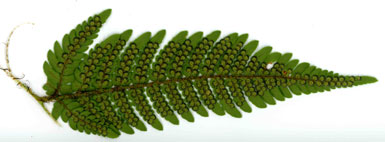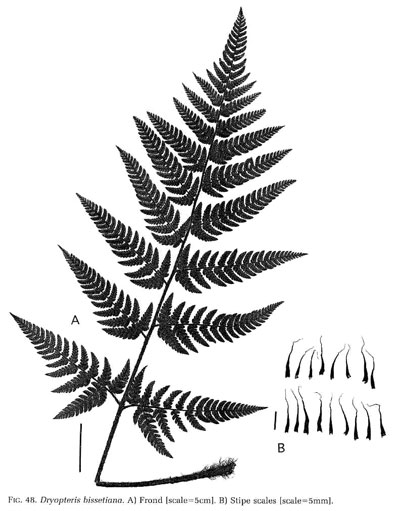| Dryopteris bissetiana | ||
Beaded wood fern | ||
|
Etymology
For a collector in Miyanosh'ta, Japan, Mr. Bissett, otherwise unidentified by J.G. Baker.
Description
Rhizome: short-creeping, clumping, scaly.
Frond: 45 cm high by 30 cm wide, evergreen, monomorphic, blade/stipe ratio: 3:1 to 1:2. Stipe: grooved, scales black, narrow triangular, vascular bundles: 3-7 in a c-shaped pattern. Blade: 3-pinnate only at the base, deltate-ovate to lanceolate, leathery, embossed upper surface, costa with small bullate scales below. Pinnae: 15 to 20 pair, lowest pinnae anadromous; pinnules triangular, curved outwards, almost entire above to pinnate below, the first lower pinnule of the lowest pinnae twice the lenth of the first upper pinnule; costae grooved above, continuous from rachis to costae; margins serrate, slightly reflexed; veins free, forked, visible on both surfaces. Sori: round, submarginal to medial, ultimate segments each bearing one sorus, indusium: reniform, greenish at maturity, attached at a sinus, sporangia: brownish, maturity: fall. Culture
Habitat: forest floor, edge of mountain forests.
Distribution: Japan, Korea, China.
Hardy to -25�C, USDA Zone 5.
Synonyms
Nephrodium bissetianum Baker Polypodium setosum Thunb Dryopteris varia (L.) Kuntze var. setosa (Thunb.) Ohwi Polystichum bissetianum Nakai Polystichum sacrosanctum Koidzumi, misapplied |
|
|

Dryopteris bissetiana. Pinna; click through for a blowup of the center. �Photo: Tom Stuart |

Dryopteris bissetiana. �Illustration from The Cultivated Species of the Fern Genus Dryopteris in the United States, Barbara Joe Hoshizaki and Kenneth A. Wilson, American Fern Journal, 89, 1, (1999), with permission. |
